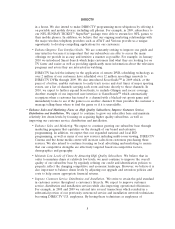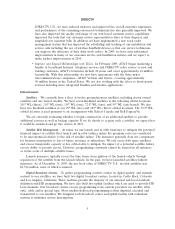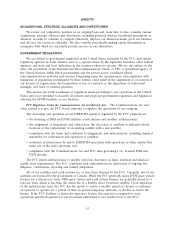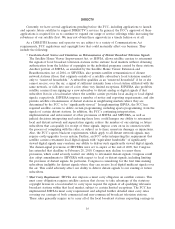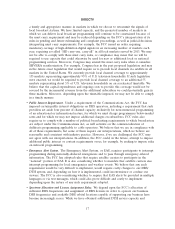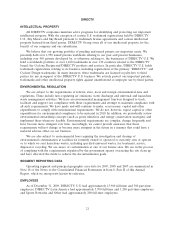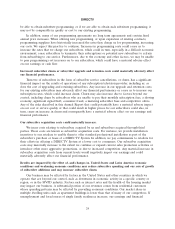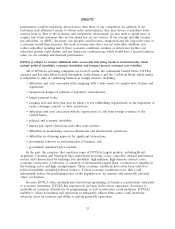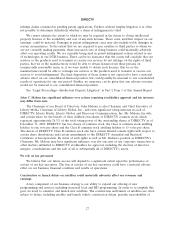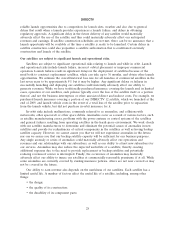DIRECTV 2009 Annual Report Download - page 30
Download and view the complete annual report
Please find page 30 of the 2009 DIRECTV annual report below. You can navigate through the pages in the report by either clicking on the pages listed below, or by using the keyword search tool below to find specific information within the annual report.DIRECTV
continue to explore new sources of DBS/DTH capacity, there can be no assurance that we will
obtain further capacity. In addition, the FCC had adopted a system of competitive bidding to
assign licenses for additional DBS frequencies. On June 21, 2005, the United States Court of
Appeals for the D.C. Circuit held that such an auction process was not authorized by statute.
The FCC subsequently voided the previous auction and implemented a freeze on applications
for authority to provide DBS service in the United States using new frequencies or new orbital
locations not assigned to the United States in the ITU Region 2 Broadcasting Satellite Service,
or BSS, Plan. On August 18, 2006, the FCC began a proceeding to identify a new system for
assigning DBS authorizations. There can be no assurance that we will be able to obtain
additional DBS capacity under whatever system the FCC implements in the future.
In 2007, the FCC adopted new service and licensing rules for the BSS in the 17.3-17.8 GHz and
24.75-25.25 GHz bands, or 17⁄24 GHz BSS. This spectrum, also known as the ‘‘reverse band’’ (in
that transmissions from these satellites to consumers would occur in spectrum currently used for
uplinking programming to traditional DBS satellites), could provide a new source of additional
DTH capacity. Among other things, the FCC established a licensing procedure under which the
four parties with applications then pending—including DIRECTV—would be allowed to amend
their applications to conform to the new rules and would be entitled to have those applications
processed on a co-equal basis with one another before any new applications would be accepted.
On July 28, 2009, the FCC granted four DIRECTV satellite applications in this band. However,
foreign operators who may have international priority have indicated an interest in using slots
that may conflict with some or all of these licenses. One foreign licensed operator, Spectrum
Five LLC, has filed a petition seeking reconsideration of one of DIRECTV’s licenses at an
orbital location where Spectrum Five also proposes to operate, and that petition remains
pending.
•Rules Governing Co-Existence With Other Satellite and Terrestrial Services and Service Providers in
the MVPD Industry. The FCC has adopted rules to allow non-geostationary orbit fixed satellite
services to operate on a co-primary basis in the same frequency band as the one used by direct
broadcast satellite and Ku-Band-based fixed satellite services. In the same proceeding, the FCC
concluded that multi-channel video and data distribution services, or MVDDS, can share
spectrum with DBS operators on a non-interference basis, and adopted rules and a method for
assigning licenses in that service, as well. While the FCC has established service and technical
rules to govern the non-geostationary orbit and MVDDS services to protect DBS operations
from harmful interference, these rules may not be sufficient to prevent such interference, and
the introduction of such services into spectrum used by us for DBS service may have a material
adverse impact on our operations. A number of aspects of these rules remain subject to judicial
review. In addition, one MVDDS operator recently requested a waiver of the applicable rules so
that it could operate systems at substantially higher power levels in 80 markets where it holds
MVDDS licenses. If granted, such a waiver may have a material adverse impact on our
operation in the affected markets. Although we have opposed that waiver request, there can be
no assurance that the FCC will deny it.
On August 18, 2006, the FCC released a notice of proposed rulemaking regarding the possible
operation of ‘‘tweener’’ or ‘‘short spaced’’ satellites—satellites that would operate in the same
DBS uplink and downlink frequency bands as us, from orbital positions located in between those
now assigned to the DBS service. This rulemaking follows applications by SES and Spectrum
Five LLC to operate tweener satellites. Under rules that the FCC is considering, a provider
could, by complying with certain technical restrictions, operate a satellite in between two orbital
locations where we have already positioned our satellites without completing coordination of its
operations with us and without demonstrating that such operations would not ‘‘affect’’ us as that
18


